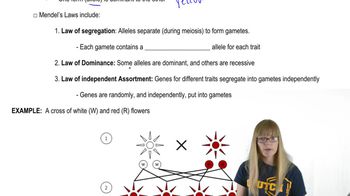Select one of the hereditary conditions from either the RUSP core conditions list or the RUSP list of secondary conditions and do some online research to find the following information:
The defect that characterizes the condition
Ch. 16 - Genomics: Genetics from a Whole-Genome Perspective
All textbooks Sanders 3rd Edition
Sanders 3rd Edition Ch. 16 - Genomics: Genetics from a Whole-Genome Perspective
Ch. 16 - Genomics: Genetics from a Whole-Genome Perspective Problem 14
Problem 14
 Sanders 3rd Edition
Sanders 3rd Edition Ch. 16 - Genomics: Genetics from a Whole-Genome Perspective
Ch. 16 - Genomics: Genetics from a Whole-Genome Perspective Problem 14
Problem 14Chapter 16, Problem 14
Select one of the hereditary conditions from either the RUSP core conditions list or the RUSP list of secondary conditions and do some online research to find the following information:
The duration of treatment
 Verified step by step guidance
Verified step by step guidance1
span>Step 1: Choose a hereditary condition from the RUSP core conditions list or the RUSP list of secondary conditions. For example, you might choose "Phenylketonuria (PKU)".</span
span>Step 2: Conduct online research using reliable sources such as medical journals, official health organization websites, or educational institutions to gather information about the chosen condition.</span
span>Step 3: Specifically look for information regarding the treatment of the condition. Focus on understanding what the treatment involves and how long it typically lasts.</span
span>Step 4: Note that for many hereditary conditions, treatment may be lifelong or require ongoing management. For instance, PKU often requires a special diet maintained throughout the individual's life.</span
span>Step 5: Summarize your findings, ensuring you have a clear understanding of the treatment duration and any factors that might influence it, such as age, severity of the condition, or advancements in medical treatments.</span

Verified Solution
Video duration:
2mWas this helpful?
Key Concepts
Here are the essential concepts you must grasp in order to answer the question correctly.
Hereditary Conditions
Hereditary conditions are genetic disorders that are passed down from parents to offspring through genes. These conditions can be caused by mutations in a single gene (monogenic), multiple genes (polygenic), or chromosomal abnormalities. Understanding the specific hereditary condition is crucial for determining its treatment options and duration.
Recommended video:
Guided course

Mendel's Laws
RUSP (Recommended Uniform Screening Panel)
The RUSP is a list of conditions recommended for newborn screening in the United States. It includes core conditions that are critical for early detection and intervention, which can significantly improve health outcomes. Familiarity with the RUSP helps in identifying which hereditary conditions are prioritized for screening and subsequent treatment.
Recommended video:
Guided course

History and Experiments
Duration of Treatment
The duration of treatment for hereditary conditions varies widely depending on the specific disorder, its severity, and the treatment approach. Some conditions may require lifelong management, while others might have a defined treatment period. Understanding the expected duration is essential for planning patient care and resource allocation.
Recommended video:
Guided course

Cancer Characteristics
Related Practice
Textbook Question
186
views
Textbook Question
Select one of the hereditary conditions from either the RUSP core conditions list or the RUSP list of secondary conditions and do some online research to find the following information:
The symptoms and consequences of the condition if it is not treated
225
views
Textbook Question
Select one of the hereditary conditions from either the RUSP core conditions list or the RUSP list of secondary conditions and do some online research to find the following information:
The recommended treatment for those with the condition
193
views
Textbook Question
Select one of the hereditary conditions from either the RUSP core conditions list or the RUSP list of secondary conditions and do some online research to find the following information:
The anticipated outcome if treatment is applied
235
views
Textbook Question
Select one of the hereditary conditions from either the RUSP core conditions list or the RUSP list of secondary conditions and do some online research to find the following information:
The frequency of the condition in newborn infants (note any populations in which the condition is more frequent)
202
views
Textbook Question
When the S. cerevisiae genome was sequenced and surveyed for possible genes, only about 40% of those genes had been previously identified in forward genetic screens. This left about 60% of predicted genes with no known function, leading some to dub the genes fun (function unknown) genes.
As an approach to understanding the function of a certain fun gene, you wish to create a loss-of-function allele. How will you accomplish this?
212
views